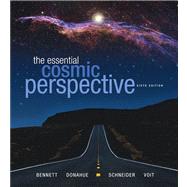
Jeffrey Bennett
Jeffrey Bennett holds a B.A. (1981) in biophysics from the University of California, San Diego, and an M.S. and Ph.D. (1987) in astrophysics from the University of Colorado, Boulder. He has taught at every level from preschool through graduate school, including more than 50 college classes in astronomy, physics, mathematics, and education. He served 2 years as a visiting senior scientist at NASA headquarters, where he created NASA's "IDEAS" program, started a program to fly teachers aboard NASA's airborne observatories (including the recently launched SOFIA observatory), and worked on numerous educational programs for the Hubble Space Telescope and other space science missions. He also proposed the idea for and helped develop both the Colorado Scale Model Solar System on the CU-Boulder campus and the Voyage Scale Model Solar System on the National Mall in Washington, D.C. (He is pictured here with the model Sun.) In addition to this astronomy textbook, he has written college-level textbooks in astrobiology, mathematics, and statistics; two books for the general public, On the Cosmic Horizon (Pearson Addison-Wesley, 2001) and Beyond UFOs (Princeton University Press, 2008); and an award-winning series of children's books that includes Max Goes to the Moon, Max Goes to Mars, Max Goes to Jupiter,and Max's Ice Age Adventure. When not working, he enjoys participating in masters swimming and in the daily adventures of life with his wife, Lisa; his children, Grant and Brooke; and his dog, Cosmo. His personal Web site is www.jeffreybennett.com.
Megan Donahue
Megan Donahue is a professor in the Department of Physics and Astronomy at Michigan State University. Her current research is mainly on clusters of galaxies: their contents-dark matter, hot gas, galaxies, active galactic nuclei-and what they reveal about the contents of the universe and how galaxies form and evolve. She grew up on a farm in Nebraska and received a B.A. in physics from MIT, where she began her research career as an X-ray astronomer. She has a Ph.D. in astrophysics from the University of Colorado, for a thesis on theory and optical observations of intergalactic and intracluster gas. That thesis won the 1993 Trumpler Award from the Astronomical Society for the Pacific for an outstanding astrophysics doctoral dissertation in North America. She continued postdoctoral research in optical and X-ray observations as a Carnegie Fellow at Carnegie Observatories in Pasadena, California, and later as an STScI Institute Fellow at Space Telescope. Megan was a staff astronomer at the Space Telescope Science Institute until 2003, when she joined the MSU faculty. Megan is married to Mark Voit, and they collaborate on many projects, including this textbook and the raising of their children, Michaela, Sebastian, and Angela. Between the births of Sebastian and Angela, Megan qualified for and ran the Boston Marathon. These days, Megan runs, orienteers, and plays piano and bass guitar whenever her children allow it.
Nicholas Schneider
Nicholas Schneider is an associate professor in the Department of Astrophysical and Planetary Sciences at the University of Colorado and a researcher in the Laboratory for Atmospheric and Space Physics. He received his B.A. in physics and astronomy from Dartmouth College in 1979 and his Ph.D. in planetary science from the University of Arizona in 1988. In 1991, he received the National Science Foundation's Presidential Young Investigator Award. His research interests include planetary atmospheres and planetary astronomy, with a focus on the odd case of Jupiter's moon Io. He enjoys teaching at all levels and is active in efforts to improve undergraduate astronomy education. Off the job, he enjoys exploring the outdoors with his family and figuring out how things work.
Mark Voit
Mark Voit is a professor in the Department of Physics and Astronomy at Michigan State University. He earned his B.A. in astrophysical sciences at Princeton University and his Ph.D. in astrophysics at the University of Colorado in 1990. He continued his studies at the California Institute of Technology, where he was a research fellow in theoretical astrophysics, and then moved on to Johns Hopkins University as a Hubble Fellow. Before going to Michigan State, Mark worked in the Office of Public Outreach
at the Space Telescope, where he developed museum exhibitions about the Hubble Space Telescope and was the scientist behind NASA’s Hubble Site. His research interests range from interstellar processes in our own galaxy to the clustering of galaxies in the early universe. He is married to coauthor Megan Donahue, and they try to play outdoors with their three children whenever possible, enjoying hiking, camping, running, and orienteering. Mark is also author of the popular book Hubble Space Telescope: New Views of the Universe.
I. DEVELOPING PERSPECTIVE
1. Our Place in the Universe
2. Discovering the Universe for Yourself
3. The Science of Astronomy
II. KEY CONCEPTS FOR ASTRONOMY
4. Making Sense of the Universe: Understanding Motion, Energy, and Gravity
5. Light: The Cosmic Messenger
III. LEARNING FROM OTHER WORLDS
6. Formation of Planetary Systems: Our Solar System and Beyond
7. Earth and the Terrestrial Worlds
8. Jovian Planet System
9. Asteroids, Comets, and Dwarf Planets: Their Nature, Orbits, and Impacts
IV. STARS
10. Our Star
11. Surveying the Stars
12. Star Stuff
13. The Bizarre Stellar Graveyard
V. GALAXIES AND BEYOND
14. Our Galaxy
15. Galaxies and the Foundation of Modern Cosmology
16. Dark Matter, Dark Energy, and the Fate of the Universe
17. The Beginning of Time
VI. LIFE ON EARTH AND BEYOND
18. Life in the Universe
The New copy of this book will include any supplemental materials advertised. Please check the title of the book to determine if it should include any access cards, study guides, lab manuals, CDs, etc.
The Used, Rental and eBook copies of this book are not guaranteed to include any supplemental materials. Typically, only the book itself is included. This is true even if the title states it includes any access cards, study guides, lab manuals, CDs, etc.